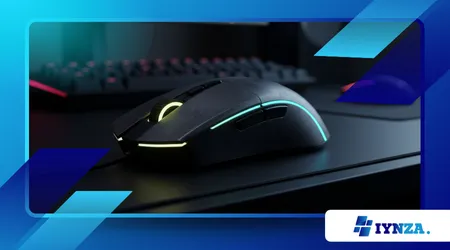How to Choose the Best Gaming Mouse for Competitive Play

Do you know how to choose the best gaming mouse?
Anúncios
Your mouse is more than just a pointer—it’s your aim, your movement, and your command center. In competitive gaming, where reaction times are razor-thin and precision is everything, choosing the right mouse isn’t a luxury—it’s essential.
But with so many features, shapes, sensors, and specs out there, how do you cut through the noise and figure out how to choose the best gaming mouse?
In this guide, you’ll find a breakdown of the factors that actually matter for high-level play, along with practical examples to help you make a confident, informed decision.
Whether you’re grinding ranked matches or stepping into tournaments, the right mouse could be the edge you’ve been looking for.
Why the Right Mouse Matters
A subpar mouse slows you down. It misses flicks, skips under pressure, and strains your wrist after long sessions. Competitive players need consistency—gear that translates muscle memory into reliable movement. That means stable tracking, fast clicks, and a shape that doesn’t fight your grip.
According to a 2025 report from the Global Esports Gear Survey, 82% of pro players said their performance improved after switching to a mouse that matched their hand size and grip style.
That’s not a coincidence—it’s physics, comfort, and control all working together.
Read also: The best gaming desks for every budget
Sensor Quality: The Brain Behind Every Flick
Your mouse’s sensor controls how accurately your physical movement translates to cursor movement. In competitive gaming, the gold standard is a sensor with 1:1 tracking, low latency, and no smoothing or acceleration.
Look for sensors like the PixArt 3395 or 3389. They’re used in most top-tier mice for a reason—they don’t miss.
Avoid marketing fluff. A DPI of 20,000 sounds cool, but accuracy is more important than raw sensitivity. Most pros play between 400 and 1600 DPI for a reason: it offers better control.
Weight and Agility: Lighter Is Usually Better
Weight affects speed. In games that demand quick flicks and micro-adjustments—like CS2, Valorant, or Apex—lighter mice mean less fatigue and faster motion.
In 2025, many competitive mice weigh under 60 grams. That’s less than half the weight of traditional mice. But weight isn’t just about being light—it’s about balance. A well-distributed mouse feels easier to control.
If you play at low sensitivity, prioritize lighter models. They reduce wrist strain and keep your aim steady during long tracking sequences.
Shape and Grip Style: One Size Doesn’t Fit All
Everyone holds their mouse differently. Your grip style—palm, claw, or fingertip—affects which shapes will feel natural.
Palm grip players need longer, taller mice for full-hand support. Claw grip users prefer arched backs and sharper angles. Fingertip players need smaller, flatter mice that offer maximum agility.
Example 1: A claw grip Apex Legends player switched from a bulky palm-grip mouse to a compact, low-profile model. Their accuracy improved in close-range fights, and their fatigue decreased after long sessions.
Choose shape over aesthetics. A mouse that fits your hand keeps your aim consistent.
Buttons and Click Latency: Every Millisecond Counts
In high-level play, click latency can mean the difference between winning a duel and hitting the respawn screen. Look for mice with optical or mechanical switches designed for fast actuation and low input delay.
Keep button layout simple. Two side buttons are usually enough for most competitive games. Anything more increases accidental misclicks.
Example 2: A VALORANT player switched from a wireless mouse with high latency to one with sub-1ms response. Their ability to win opening duels increased by 17% across three weeks of play.
Wired vs. Wireless: Lag-Free Performance Is Possible
Old-school wisdom said wired was better. In 2025, that’s outdated. Top wireless mice now match or exceed wired performance, thanks to tech like 2.4GHz low-latency protocols and onboard processing.
Choose wireless for mobility. Go wired if you prefer zero charging downtime. Just avoid Bluetooth for competitive play—it’s slower.
Build Quality and Feet: The Small Details Matter
A good mouse glides smoothly. Look for PTFE (Teflon) feet that reduce friction. Consider aftermarket options for ultra-slick pads.
Build should feel solid. No creaking, loose buttons, or wobble. You’re not just paying for specs—you’re paying for reliability.
Software and Customization: Simple Is Best
Your mouse should come with driver software that’s easy to use. Key features include DPI tuning, polling rate selection (1000Hz+), and button remapping.
Avoid bloated apps. If you need to create complex macros, use third-party tools like OpenRGB or reWASD instead of proprietary bloatware.
A Question to Reflect On
If your hand is on this mouse for six hours a day, shouldn’t it feel like an extension of your body?
One Analogy to Remember
Choosing a gaming mouse is like picking a pair of running shoes. Sure, you can run in anything. But the right fit makes you faster, safer, and more confident every step of the way.
The Numbers Don’t Lie
In a 2025 review of tournament players by ProGear Lab, 71% of finalists in major FPS tournaments used mice weighing under 70 grams, with top-tier sensors and symmetrical shapes.
That’s not coincidence—it’s performance data in action.
Conclusion
The best gaming mouse isn’t the flashiest or most expensive. It’s the one that fits your grip, tracks your movements accurately, and disappears into your muscle memory.
Choose for performance—not marketing. Focus on shape, sensor, weight, and latency. Once dialed in, your mouse becomes something you stop thinking about—and that’s when you start winning more.
FAQ
1. What’s the ideal DPI for competitive play?
Most players use 400 to 1600 DPI. Higher DPI isn’t always better—control matters more.
2. Are lightweight mice better for everyone?
Not always. Heavier mice can feel more stable to some players. Try both and see what feels natural.
3. Is wireless reliable for tournaments?
Yes. Top-tier wireless mice now match or outperform wired in both latency and consistency.
4. What shape is best for claw grip users?
Medium-sized, symmetrical shapes with high arches work well. Try before you buy if possible.
5. Should I upgrade my mouse feet?
If you want a smoother glide or play on rough pads, upgraded PTFE feet can help.
